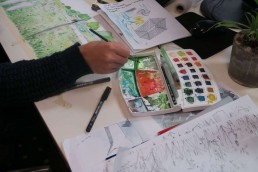
lala.ruhr ist das Labor für die Landschaft der Metropole Ruhr – eine Biennale der urbanen Landschaft!
Pleading for a strong landscape architecture
Few professions are as influential on space as landscape architecture. As soon as we move outside, we are already in the midst of the work of landscape architects – whether in the park, on the playground or schoolyard, on the bike path or on the marketplace in our own neighborhood. Nevertheless, only a few people can really classify the profession, sometimes it is even considered an “exotic niche”. Landscape architects who talk about their work with friends and acquaintances after work are sometimes asked why they need a degree to “put up a piece of playground equipment or a bench”.
Why is that?
On the one hand, it’s because many clients think they can take over our work right away or delegate it to people outside the field: “We’ll just do the outdoor area quickly”. Or they take over the open spaces and pour concrete. The remaining square meters can then basically only be described as residual areas – the origin of bulky terms such as clearance green and verges. And you don’t need experts for that, do you?
Yet the field of landscape architecture is growing steadily, and is becoming ever larger and more urgent, not least due to advancing climate change. Well-designed, sufficiently dimensioned and functioning urban landscapes satisfy elementary needs – the pandemic has just shown us all how valuable green open spaces are.
The requirements for multifunctional urban landscapes are becoming increasingly diverse and comprehensive:
The profession of landscape architect has expanded enormously over the past twenty years and is currently linked to many issues of the future. Landscape architecture as an integrating discipline faces up to these tasks, brings experts together and often finds forward-looking solutions for challenging issues – and this despite the fact that the discipline continues to operate only in the background in the public perception. As a design discipline, landscape architecture is also interested in aesthetic and at the same time technical solutions – how many professional fields are based on such a challenging balancing act?
Model solutions for many of the new challenges arising from the pandemic and climatic changes do not yet exist. Accordingly, a great deal of courage will be needed in the coming years – on the part of planners as well as municipalities and clients – to try out model solutions and set new landscape standards and break down outdated notions of roadside greenery.
We need a collaborative professional practice to develop solutions that move us forward. And, most importantly, we need more young people to choose this wonderful and little-known profession – it sometimes doesn’t even appear in career counseling databases for high school students – because it is exciting and offers so many challenges.
As a partner in a planning office, I am also concerned about the educational situation in the Ruhr region in particular: a huge, transformative metropolitan area without a single landscape architecture degree program. This is a wasted opportunity for the region, as it is students in particular who develop fresh ideas for their surroundings – beyond the familiar solutions.
Isabella de Medici hat Landschafts- und Freiraumplanung in Hannover und Barcelona studiert und lebt seit über 20 Jahren im Ruhrgebiet. Seit 2017 ist sie Gesellschafterin bei der Planungsbüro DTP Landschaftsarchitekten GmbH, hat einen Lehrauftrag bei der FH in Dortmund, ist Sprecherin für Freiraum beim bdla nrw und Teil des Teams von lala.ruhr.